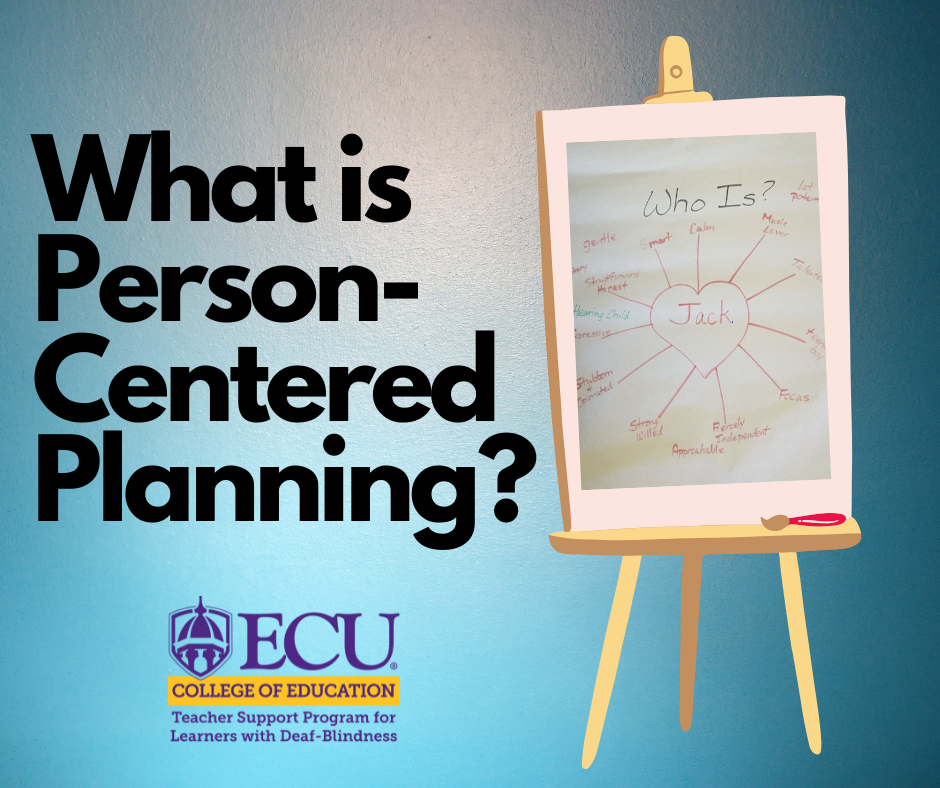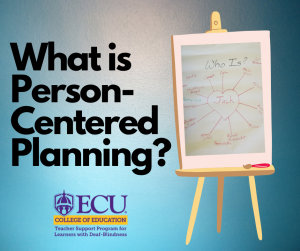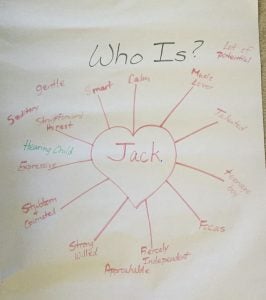Person-Centered Planning (PCP) is designed to shift the focus from a deficit-based to a strength-based approach in developing transition and life plans that enhance an individual’s quality of life.
~ Beth Mount
The main purpose of education for learners with deafblindness is to prepare them for the future in a multitude of ways. How does that happen? Well, one great example is through transition and life planning using the Person-Centered Planning (PCP) process. It’s a collaboration that brings together individuals who know the learner. Through the organized process, these individuals share knowledge of the learner to create a set of maps that provide meaningful information. The maps are used to make plans for the future by identifying and prioritizing needs and setting goals. This unique method leads to the development of an action plan that focuses on overcoming fears or barriers and turning dreams into realities.
PCP’s have many benefits, such as:
- Focuses on the learner and the family as the lead in the process
- Focuses on the positive, highlighting the student’s abilities and interests
- Does not dwell on the student’s shortcomings and challenges
Typical educational planning is more geared towards school-based decision-making. The school decides when, where and who should meet; professionals take the lead. The team is composed mainly of school personnel and heavily weighted with professionals. It relies on formal measures and results of standardized assessments. With typical planning, the team meets annually (unless additional meetings are requested by family or educational team). Much of the information gathering takes place prior to the meeting. The focus is on where students ought to be and primarily considers educational goals. This process may focus on deficits and weaknesses and emphasize skills needed for academic and/or vocational progress.
With the Person-Centered Planning process, the family decides who to invite and where to meet; the student/family takes the lead. The team is composed of a broad spectrum of individuals who know the student in a variety of settings. The process relies on information supplied by persons who know students in a variety of ways. The whole team or certain members meet when necessary. Participants provide information and develop plans during the meeting(s). The focus is on where a student wants to be. It takes a holistic approach, setting educational goals in the context of life planning. The PCP always focuses on positive qualities, strengths, and interests. Lastly, it emphasizes skills needed for education, employment or volunteer activities, independent living skills, and community participation.
Once a family or team member decides to conduct a Person-Centered Planning session, they follow the steps listed:
- Assemble the Team
- Create basic maps
- Choose and create optional maps
- Determine Needs
- Identify and Prioritize goals
- Identify resources and support.
- Develop Action Plan(s).
- Monitor progress (Keep things moving).
- Re-assemble all or part of the team as needed.
- Review/revise maps when things change.
Before the team meets collaboratively, they determine which maps will be used to guide the development of the Action Plan. Although there are many choices of maps, the most common are listed below:
- History Map
- Relationship Map
- Preference Map
- Places Map
- Who Is? Map
- Expressive/Receptive Map
- Dreams Map
- Choices Map
- Ideal Day Map
- Needs Map
- Action Plan
Check out the ECU Mast Modules for more detailed information about the specific maps and the process.
On-Going Uses of Maps
There are many benefits to the long-term use of the maps as related to IEP development. PCP’s provide guidance for goals for employment & independent living. They also provide preparation for provider & adult agency meetings. The maps address additional priorities as action steps are completed. Just think of how great it would be if a learner began the PCP process in preschool and carried it on through adulthood! What a way to effectively guide the learner towards their future!
Sustaining the Process
Teams have seen positive results creating and using Person-Centered Plans and work hard to sustain the process over time. Continuing to use particular maps to guide educational planning, keeping information and actions plans up-to-date enables a learner and his or her support team to maximize their investment in this process and improve learner outcomes and quality of life. Person-Centered Planning is not just for post-secondary transition. It can be used at any age …. even in preschool!
Check out the ECU Mast Modules to learn more about this valuable form of future planning for learners. Also, contact us if you are interested in beginning the PCP process with a learner and their team.
Have you participated in the Person-Centered Planning process? If so, please tell us about your experience in the comment section below!
https://mast.ecu.edu/Person%20Centered%20Plans%20for%20Education/Introduction/index.html
Julie Brickhouse, M.Ed.,NBCT, East Carolina University DeafBlind Project Teacher Support Program, Technical Assistance Consultant



